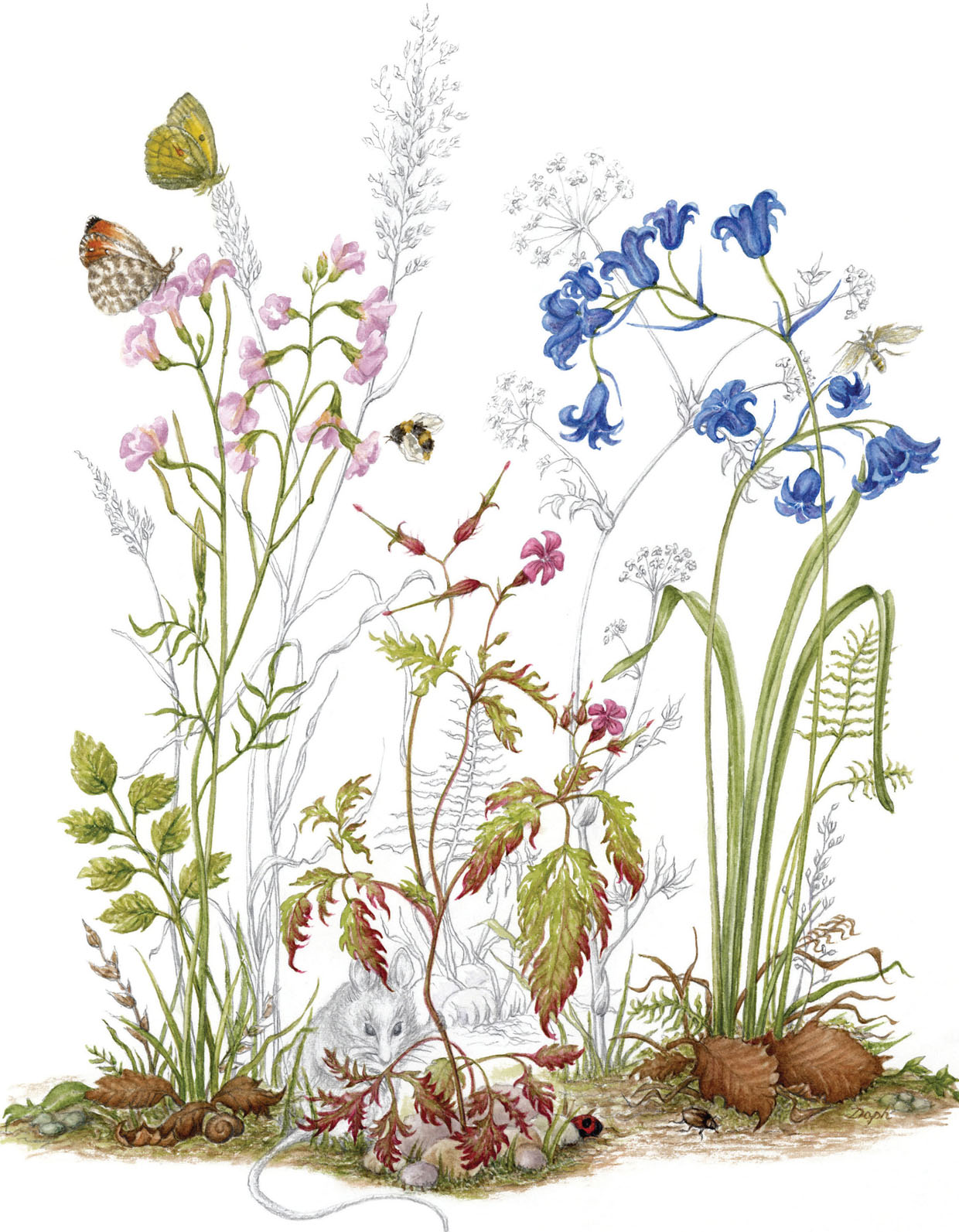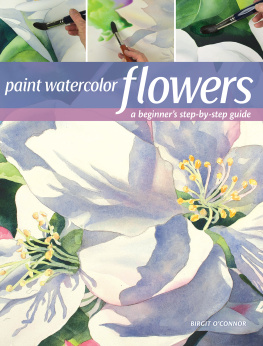
Botanical
Painting with
Watercolour
DAPHNE HICKS

THE CROWOOD PRESS
First published in 2014 by
The Crowood Press Ltd
Ramsbury, Marlborough
Wiltshire SN8 2HR
www.crowood.com
This e-book first published in 2014
Daphne Hicks 2014
All rights reserved. No part of this publication may be reproduced or transmitted in any form or by any means, electronic or mechanical, including photocopy, recording, or any information storage and retrieval system, without permission in writing from the publishers.
British Library Cataloguing-in-Publication Data
A catalogue record for this book is available from the British Library.
ISBN 978 1 84797 801 1
Frontispiece: Delphinium, White Iris, Perennial Sweet Pea and Astrantia. A composition from the garden showing complementary shades of blue, pink and creamy white. The Delphinium needs the intensity of Ultramarine blue, so the Perennial Sweet Pea also needs a cool pink containing blue, such as Alizarin Crimson Hue, echoed again with a more delicate pink tone in the Astrantia.
Verses by Daphne Hicks
Acknowledgements
A Study of a Spray of Withered Oak Leaves by John Ruskin is reproduced by kind permission of the Collection of the Guild of St George Museums, Sheffield. Anemone Coronaria, Hortus Eystettensis by Basilius Besler (15611629) is reproduced by kind permission of Teylers Museum, The Netherlands. Datura Brugmansia arborea with Humming Birds by Marianne North is reproduced by kind permission of the Director and the Board of Trustees, Royal Botanic Gardens, Kew.
Grateful thanks go to my wonderful photographers, Stephen Meredith and Andrew Boid from Visual EvidenceFine Art Reproduction, who have so beautifully reproduced my paintings with great care, and thanks to Nigel Walker from Creation Fine Arts Gallery in North Bar, Beverley, for putting me in touch with them and for his support. I owe many thanks to my tutors at the Botanical Society, London, where I gained my Society Diploma; without their encouragement and guidance, especially in the early years, I would not have been where I am today, and this book would not have been possible. Also a big thank-you goes to all those who have attended my classes so enthusiastically. I consider it a privilege and a pleasure to be able to teach and guide people, and see the fabulous results that are produced, and I hope to continue doing so. Last but not least, a big thank-you is due to all those private collectors who have bought my work to hang on their walls, and especially to Dudley Chapman of Lloyd Warwick Ltd. I do appreciate your support.
CONTENTS

Red Creeper over Acacia. A large painting in a more contemporary style and using a limited palette of colours, Cadmium red, Alizarin crimson, Cadmium yellow, Yellow ochre and Umber. The flowing red creeper hangs down over the more structured Acacia giving a curtain of glorious colour.
PREFACE
This book is primarily intended to inspire the beginner to have a go at botanical drawing, but I hope that more experienced artists will also find a little something extra to add to their skills.
If you are intimidated by the prospect of beginning on a blank piece of paper (as indeed many artists are), choose your subject carefully. Find a flower or a plant that gives you a buzz, whether in its colour, its shape or its texture. Pick a subject that really speaks to you, that says to you Draw me! If you come to love using watercolours as much as I do, and enjoy the experience of learning, persevere with your botanical work and you will derive great enjoyment from watching the painting develop beneath your hands, be it crimson Holly berries against dark green spiky leaves, or delicate spring flowers such as Primroses, Daffodils and Tulips.
The thrill of producing beautiful pictures with these glowing colours offers immense pleasure and satisfaction. Happy painting!
Daphne Hicks, 2014

Mouse with Berry. This was fun to do, and good experience at achieving a variety of textures with soft fur, translucent berry, and shining eyes!

Wild Flowers. Delicate wayside flowers need a light hand with fine lines, but this does not necessarily mean pale colouring, it is still important to show strong shadows and depths to define the plants. Adding a pencil sketch of the mouse and grasses adds interest without dominating the study.
CHAPTER 1
AN INTRODUCTION TO BOTANICAL ART
How it All Began
As a child born in a market town on the edge of the Yorkshire Moors in the 1940s, I was very fortunate to have easy access to rambling countryside on my doorstep. I was one of four children and we were used to the freedom of packing a few biscuits and a drink in an old canvas satchel and going off up the Vale early in the morning, only returning when our stomachs told us it must be lunchtime. My bag also held a pencil and notebook to take notes and make little sketches, and possibly an empty jamjar just in case I came across a caterpillar or a butterfly or some other sample. We knew exactly where the Primroses and sweet scented Violets would be growing and picked them without restriction in those days. How lucky we were, growing up with such treasures as Early Purple Vetch, Bugle and Cowslips, which we gently pulled apart to sip the sweet nectar from inside the flowers. Who taught us to do that? I really dont remember it was just one of those things that country children knew. There were hosts of golden daffodils to be seen at Farndale and Rumsgill, and at nearby Spring Wood a carpet of Bluebells, Wood Anemones and Wild Garlic. In another area drifts of dainty white Lilies of the Valley could be found, their scent leading us to their hiding place. We knew where to find mauve and yellow wild Iris growing around a pond, and in summer the hedgerows were full of pink and white wild Roses, soon to be followed by the glossy red hips which we gathered with my mother. These we took to a collection point in the town to be weighed, in return for a few coins. The hips were sent off to be turned into Rosehip syrup, which was made available through the new Health Services local clinic, to be spooned into babies and young children to provide vitamins in those hungry post-war days.

Dog Rose (Rosa canina) can still be found in country hedgerows and is delightful to come across in its wild state; it may be pink or white.
We stained our fingers purple gathering elderberries and blackberries for pies, and once my mother made Gale beer with yeast, not knowing how potent it would be. (We all remember the shock when the bottles, which were fermenting in the cellar, blew their tops off with a loud report like gunshots! I seem to remember that what remained of the beer was poured down the drain without being tasted as my mother was a fairly strict Wesleyan Methodist, and nothing other than communion wine or a small port and lemon at weddings was to pass her lips.) We learned to identify edible types of fungus to bring home, but I was rather squeamish when my brother broke open huge puffballs to reveal the insects scurrying around inside. Hazelnuts were plentiful and we filled our bags with them. I also enjoyed finding the little rough cups in the grass with the smooth shiny acorns nestling inside, and I still have one today in my workbox where it has stayed all these years.


















